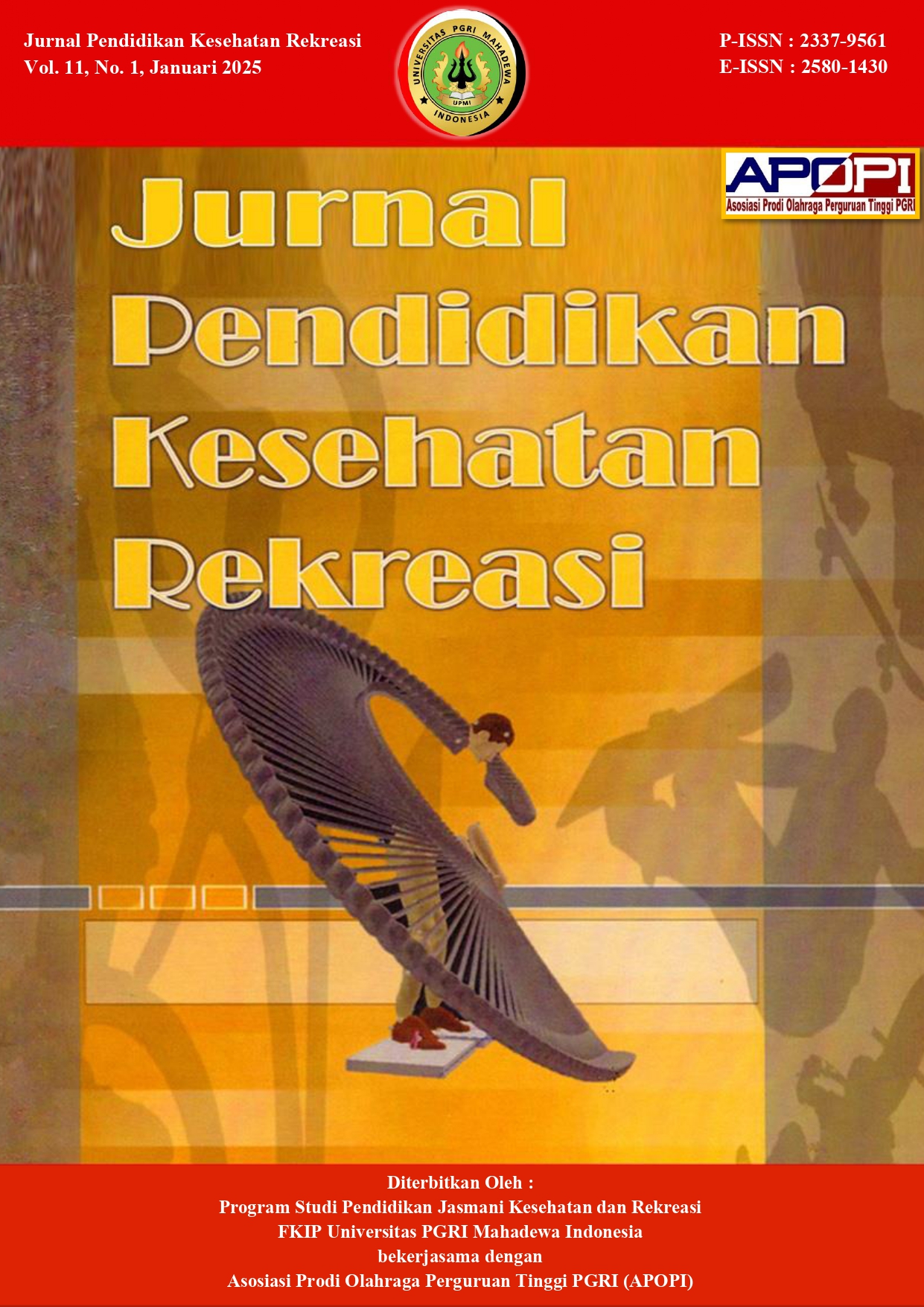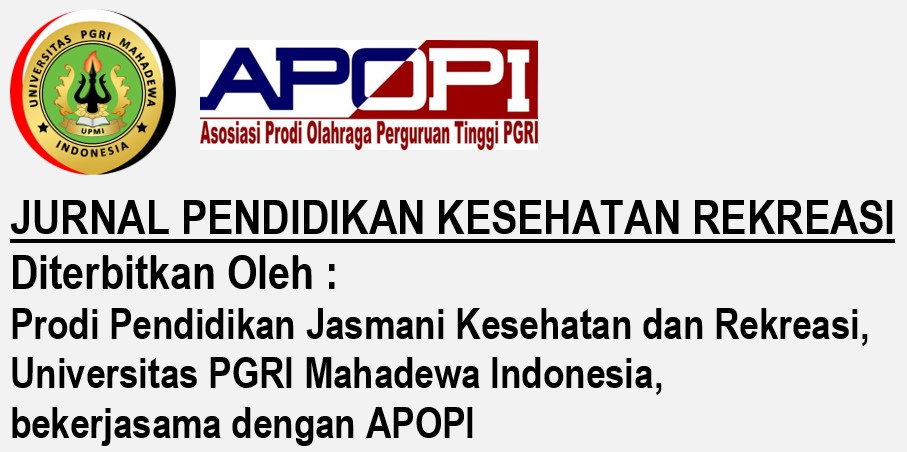Hubungan antara Daya Tahan Otot Inti dan Kemampuan Lokomotor Anak dengan Down Syndrome
DOI:
https://doi.org/10.59672/jpkr.v11i1.3880Keywords:
daya tahan otot inti, lokomotor, down syndromeAbstract
Belum ditemukan hasil penelitian terkait hubungan daya tahan otot inti dengan kemampuan lokomotor anak dengan Down syndrome, padahal dengan mengetahui arah dan derajat hubungannya akan berkontribusi untuk penentuan tujuan pelatihan atau terapi fisik bagi anak-anak dengan Down syndrome sehingga penelitian ini bertujuan untuk mengetahui hubungan antara daya tahan otot inti dan kemampuan lokomotor dengan melibatkan 30 anak dengan Down syndrome yang dipilih menggunakan teknik purposive sampling. Semua sampel mengikuti prosedur penelitian dengan mengukur daya tahan otot inti menggunakan uji plank dan penilaian kemampuan lokomotor dengan test of gross motor development-2nd edition (TGMD-2). Teknik analisis statistik menggunakan uji korelasi Pearson pada taraf signifikansi α=0,05. Hasil analisis statistik menunjukkan ada hubungan positif yang signifikan antara daya tahan otot inti dan kemampuan lokomotor dengan nilai signifikansi 0,000 (Sig.<0,05) dan nilai korelasi pearson positif sebesar 0,843 maka dikatakan bahwa daya tahan otot inti berhubungan positif secara signifikan dengan kemampuan lokomotor pada tingkat sempurna. Daya tahan otot-otot inti harus ditingkatkan melalui pelatihan untuk mendukung upaya peningkatan kemampuan lokomotor anak-anak dengan Down syndrome.
Downloads
References
Abhilash, P. V., Sudeep, S., & Anjana, K. (2021). Relationship between core endurance and dynamic balance in professional basketball players: A pilot study. International Journal of Physical Education, Sports and Health, 8(4), 1–5. Retrieved from https://www.kheljournal.com/archives/2021/vol8issue4/PartA/8-3-74-346.pdf
Aly, S. M., & Abonour, A. A. (2016). Effect of core stability exercise on postural stability in children with down syndrome. International Journal of Medical Research & Health Sciences, 5(10), 213–222. Retrieved from https://www.ijmrhs.com/medical-research/effect-of-core-stability-exercise-on-postural-stability-in-children-with-downsyndrome.pdf
Anugrah, T., Suhartini, B., Sukarmin, Y., & Simatupang, N. (2023). Literature review: Bagaimana kinerja latihan core stability dalam meningkatkan keseimbangan tubuh individu down syndrome?. Jurnal Pendidikan Kesehatan Rekreasi, 9(1), 31–42. https://doi.org/10.5281/zenodo.7504864
Anugrah, T., Sumaryanti, S., Simatupang, N., Sutapa, P., Ambardini, R. L., & Nugroho, S. (2023). The relationship of dynamic body balance with locomotor ability and endurance of core muscles in children with down syndrome. Journal of Kinesiology and Exercise Sciences, 102(33), 1–8. https://doi.org/10.5604/01.3001.0053.4084
Barati, A., Safarcherati, A., Aghayari, A., Azizi, F., Abbasi, H. (2013). Evaluation of relationship between trunk muscle endurance and static balance in male students. Asian Journal of Sports Medicine, 4(4), 289–294. https://doi.org/10.5812/asjsm.34250
Bibro, M., Jankowicz-Szymańska, A., Wódka, K., & Łaczek-Wójtowicz, M. (2019). Impact of intellectual disability on longitudinal arch and symmetry of the lateral and medial load of the foot. Health Promotion & Physical Activity, 6(1), 28–32 (29. https://doi.org/10.5604/01.3001.0013.1562
Boyer, C., Tremblay, M., Saunders, T., McFarlane, A., Borghese, M., Lloyd, M., & Longmuir, P. (2013). Feasibility, validity, and reliability of the plank isometric hold as a field-based assessment of torso muscular endurance for children 8–12 years of age. Pediatric Exercise Science, 25(3), 407–422. https://doi.org/10.1123/pes.25.3.407
Boz, H. K., & Temur, H. B. (2020). The relationship between core stability and some performance parameters between fourteen and sixteen year old group male long distance runners and football players. African Educational Research Journal, 8(2), 352–356. https://doi.org/10.30918/AERJ.82.20.076
Cengizhan, P. A., Cobanoglu, G., Gokdogan, C. M., Zorlular, A., Akaras, E., Orer, G. E., Kafa, N., & Guzel, N. A. (2019). The relationship between postural stability, core muscle endurance and agility in professional basketball players. Annals of Medical Research, 26(10), 2181–2186. https://doi.org/10.5455/annalsmedres.2019.07.436
Daud, D. M., Razak, N. R., Lasimbang, H. (2015). Core stability deficits in female knee osteoarthritis patients. Academic Journal of Science, 4(3), 117–124. Retrieved from http://www.universitypublications.net/ajs/0403/html/R5ME26.xml
Demirdel, S., Gül, G., Gümüş, Ö., & Kuz, B. (2022). The effect of different jaw positions on upper extremity performance, core endurance, and postural stability: A cross-sectional study. Turkish Journal of Kinesiology, 9(1), 1–6. https://doi.org/10.31459/turkjkin.1232047
Esfahani, N. H., Dommerholt, J., & Rezaeian, Z. S. (2021). Core muscles endurance in sedentary staffs with and without nonspecific chronic low back: A cross-sectional study. Muscles, Ligaments and Tendons Journal, 11(1), 136–150. https://doi.org/10.32098/mltj.01.2021.15
Fallahasady, E., Rahmanloo, N., Seidi, F., Rajabi, R., & Bayattork, M. (2022). The relationship between core muscle endurance and functional movement screen scores in females with lumbar hyperlordosis: A cross-sectional study. BMC Sports Science, Medicine and Rehabilitation, 14(182), 1–8. https://doi.org/10.1186/s13102-022-00567-2
Foley, C., & Killeen, O. G. (2019). Musculoskeletal anomalies in children with down syndrome: An observational study. Archives of Disease in Childhood, 104, 482–487. https://doi.org/10.1136/archdischild-2018-315751
Giustino, V., Messina, G., Alesi, M., Mantia, L. L., Palma, A., & Battaglia, G. (2021). Study of postural control and body balance in subjects with down syndrome. Human Movement, 22(1), 66–71. https://doi.org/10.5114/hm.2021.98466
Guzman-Muñoz, E. E., Gutierrez-Navarro, L. B., & Miranda-Diaz, S. E. (2017). Postural control in children, adolescents and adults with down syndrome. Revista Médica Internacional sobre el Síndrome de Down, 1–6. http://dx.doi.org/10.1016/j.sdeng.2016.09.003
Hardika, N., & Fuzita, M. (2021). Pengembangan keterampilan gerak dasar lokomotor berbasis senam ritmik. Jurnal Pendidikan Olahraga, 10(2), 263–272. https://doi.org/10.31571/jpo.v10i2.3295
Hung K-C, Chung H-W, Yu CC-W, Lai H-C, Sun F-H (2019) Effects of 8-week core training on core endurance and running economy. PLoS ONE, 14(3), 1–12. https://doi.org/10.1371/journal.pone.0213158
Jain, P. D., Nayak, A., Karnad, S. D., & Doctor, K. N. (2022). Gross motor dysfunction and balance impairments in children and adolescents with down syndrome: A systematic review. Clinical and Experimental Pediatrics, 65(3), 142–149. https://doi.org/10.3345/cep.2021.00479
Jankowicz-Szymańska, A., Wódka, K., Kawa, J., & Kwiek, B. (2022). Comparison of trunk alignment and postural habits of high school adolescents and university students. Health Promotion & Physical Activity, 20(3), 11–22. https://doi.org/10.55225/hppa.437
Krishna, H. S., Shetty, S., & Raj, A. S. (2020). Relationship between core endurance and dynamic balance in college level football players: A pilot study. International Journal of Physical Education, Sports and Health, 7(5), 149–153. Retrieved from https://www.kheljournal.com/archives/2020/vol7issue5/PartC/7-4-81-971.pdf
Mohammadi, H., & Fathi, J. (2018). The relationship between core endurance and performance in national female badminton athletes. Physical Treatments, 8(3), 123–131. http://dx.doi.org/10.32598/ptj.8.3.123
Padmanabhan, S. B. R., & Anju, R. P. P. (2020). Relationship between dynamic balance and fine motor performance with core endurance in school children. International Journal of Science and Healthcare Research, 5(4), 285–291. Retrieved from https://ijshr.com/IJSHR_Vol.5_Issue.4_Oct2020/IJSHR0037.pdf
Santos, M. S., Behm, D. G., Barbado, D., DeSantana, J. M., & Da Silva-Grigoletto, M. E. (2019). Core endurance relationships with athletic and functional performance in inactive people. Frontiers in Physiology, 10, 1–8. https://doi.org/10.3389/fphys.2019.01490
Shaikh, A. I., Nuhmani, S., Kachanathu, S. J., & Muaidi, Q. I. (2019). Relationship of core power and endurance with performance in random intermittent dynamic type sports. Asian J Sports Med, 10(1), 1–7. https://doi.org/10.5812/asjsm.62843
Trioclarise, R., Sitompul, M., & Syakib, A. (2022). Perbedaan hubungan fungsi sensoris dan core stability terhadap keseimbangan dinamis pada anak usia 3–5 tahun di al-fatih center tangerang. Jurnal Fisioterapi dan Kesehatan Indonesia, 02(02), 163–174. Retrieved from https://ifi-bekasi.e-journal.id/jfki/article/view/119
Tun, M. T., Aye, T., & Khin, M. T. (2021). Inter-rater reliability of the test of gross motor development second edition (TGMD-2) for children with down syndrome: A pilot study. The Journal of Asian Rehabilitation Science, 4(3), 39–46.
Wang, H. Y., Long, I. M., & Liu, M. F. (2012). Relationships between task-oriented postural control and motor ability in children and adolescents with down syndrome. Research in Developmental Disabilities, 33(6), 1792–1798. https://doi.org/10.1016/j.ridd.2012.05.002
Zulfiqar, H., Rehman, M. U., Razzaq, A., Nisa, Z. U., Hina, M., Bashir, H., Saeed, H., & Ashraf, N. U. S. (2022). Effect of core stability exercises and balance training in postural control among children with down syndrome. Pakistan Biomedical Journal, 5(7), 18–22. https://doi.org/10.54393/pbmj.v5i7.392
Downloads
Published
How to Cite
Issue
Section
License
Copyright (c) 2025 Tama Anugrah, Sumaryanti, Nurhayati Simatupang, Adhyani Prameswara, Ready Prasetyo, Wahyullah

This work is licensed under a Creative Commons Attribution-NonCommercial-ShareAlike 4.0 International License.
Jurnal Pendidikan Kesehatan Rekreasi is published under the terms of Creative Commons Attribution 4.0 International License / CC BY NC SA 4.0. This license permits others to copy, distribute, modify, and create derivative works for non-commercial purposes only


































